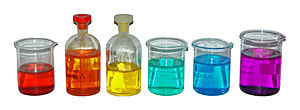 Image via Wikipedia
Image via Wikipedia
Magnetic iron nanocatalysts
Easily recoverable, green and effective catalysts
Iron oxide nanoparticles make efficient recyclable catalysts for organic reactions say a team of scientists in Canada.
Environmentally friendly, economical and efficient catalysts for carbon–carbon bond forming reactions are desirable for industrial chemists. Magnetically recoverable catalysts are especially attractive due to their ease of separation from the reaction mixture. Chao-Jun Li and colleagues at McGill University, Montreal, have shown that iron oxide nanoparticles are efficient magnetic catalysts that can be reused up to 12 times without losing their effectiveness.
Immobilised or supported iron oxide nanoparticles have been used as catalysts before but their direct use without modification as magnetically recoverable catalysts for organic reactions is very rare, explains Li. His team demonstrated the nanoparticles effectiveness in the synthesis of important medicinal chemistry intermediates, propargylamines. Thanks to the magnetic character of the nanoparticles, they stick onto the magnetic stirring bar and are easily separated so they can be washed before being used again.
‘The separation and reuse of the magnetic iron oxide nanoparticles were very simple, effective and economical. In addition, the use of iron oxides as catalysts is also more environmentally friendly and safer than other transition metal catalysts,’ says Li.
Unni Pillai, an expert on green chemistry and catalysis at Dow Corning Corporation, Carrollton, US, says that ‘the ease of separation of these catalysts helps to avoid difficult and elaborate separation procedures involving filtration and centrifuging equipment and solvents; thereby contributing immensely to the ‘environmentally friendly’ aspects of the process.’
Li explains the team plan to explore the catalyst for other organic reactions. ‘A widespread expansion of these catalysts’ application is anticipated in the near future,’ adds Pillai.
Lorena Tomas Laudo
Photocatalyst sees the light
Energy saving bismuth photocatalyst works under visible light
A nanoparticle photocatalyst that works under natural light and could be used to remove pollutants from water has been developed by scientists in China and Japan.
Photocatalysts use light to speed up a reaction but most need ultraviolet (UV) light to work. Now, Renhong Li at the Zhejiang Sci-Tech University, China, and colleagues have used bismuth to make a catalyst that works under visible light.
Li’s catalyst uses platinum nanoparticles loaded with the semiconductor bismuth oxide (Bi2 O3 ). The Bi2 O3 allows transfer of electrons to take place on excitation by visible light. This generates holes on the surface that decompose organic molecules such as acetaldehyde and formaldehyde.
The reaction rates achieved by this new catalyst are comparable to ones that use UV light, says Bi2 O3 catalyst is very useful for energy saving purposes,’ he adds.
Leonardo Palmisano, a photocatalysis researcher at the University of Palermo, Italy, says ‘this shows some convincing results on the photo-oxidation of organic pollutants under visible light illumination, demonstrating an important plasmonic effect for Pt/Bi2 O3 photocatalysts.’ He adds that he sees promising applications for the new catalyst.
Li says that this research could provide advances in the use of platinum and other noble metals photocatalysts, such as the use of photocatalysts in water splitting under visible light which is an area the team hope to explore further.
Rebecca Brodie
Reference
R Li, et al, Green Chem., 2010, DOI: 10.1039/ b917233e
Technorati Cosmos: other blogs commenting on this post
![Reblog this post [with Zemanta]](http://img.zemanta.com/reblog_b.png?x-id=ee4f00ac-440c-44e5-8d88-2330024038d6)
No comments:
Post a Comment